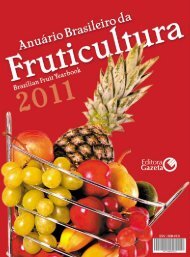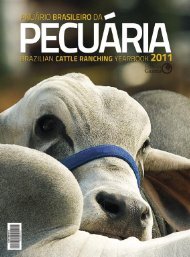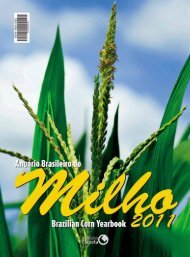tradicionalmenteinovador - Brazil Buyers & Sellers
tradicionalmenteinovador - Brazil Buyers & Sellers
tradicionalmenteinovador - Brazil Buyers & Sellers
You also want an ePaper? Increase the reach of your titles
YUMPU automatically turns print PDFs into web optimized ePapers that Google loves.
Stage by stage<br />
>> IAC specialists identify the causes of the post-harvest<br />
losses and show the wayout of the problem<br />
Vegetables are subject to significant<br />
after-harvest losses, which start in the<br />
field and continue all the way along<br />
the chain, including packing-houses,<br />
supply centers, wholesale stores, retail<br />
outlets and consumers. Juliana Sanches,<br />
researcher for the Automation and<br />
Engineering Center at the Agronomic<br />
Institute of Campinas (IAC) explains<br />
what these losses are all about. “A loss<br />
is the part of the crop that is not destined<br />
for consumption, by virtue of the<br />
depreciation of the quality, caused by<br />
a deterioration process, crushing, cuts,<br />
rot and other factors”, she observes.<br />
For the most part, waste is produced<br />
by poor handling, improper packaging<br />
or transportation, the lack of refrigeration,<br />
ignorance about the harvest and<br />
post-harvest handling practices, sales<br />
in bulk and excessive handling by final<br />
buyers, as well as by the accumulation<br />
of products on the supermarket<br />
display shelves or deficiencies in the<br />
wholesale posts.<br />
Post-harvest losses, explains Juliana<br />
Sanches, are split into physiological,<br />
mechanical injury and phytopathological.<br />
“Physiological losses in vegetables<br />
occur due to such problems<br />
as respiration, transpiration, ripening<br />
and senescence, but they could also be<br />
induced by excessively warm or cold<br />
temperatures and low relative humidity”,<br />
she notes. “Mechanically-induced<br />
losses occur all the way along the productive<br />
chain, while phytopathological<br />
damages are caused by outbreaks<br />
of micro-organisms at pre or post harvest<br />
time”.<br />
At the Fruit, Vegetables and Ornamental<br />
Plant Post-Harvest Laboratory,<br />
run by the IAC Automation and Engineering<br />
Center, inaugurated in July<br />
2009, the studies involve post-harvest<br />
conservation techniques and vegetable<br />
grading operations. The crops undergoing<br />
studies are as follows: beet,<br />
potato, okra, broccolis, ruccula babyleaf,<br />
lettuce, watercress, strawberry,<br />
green corn and tomato.<br />
Inor Ag. Assmann<br />
83





